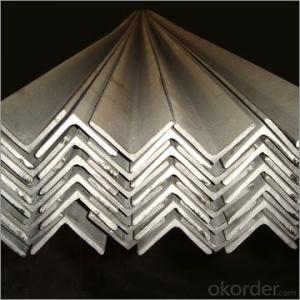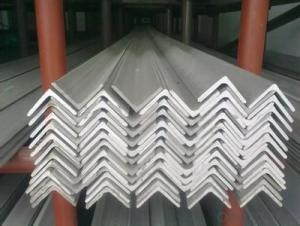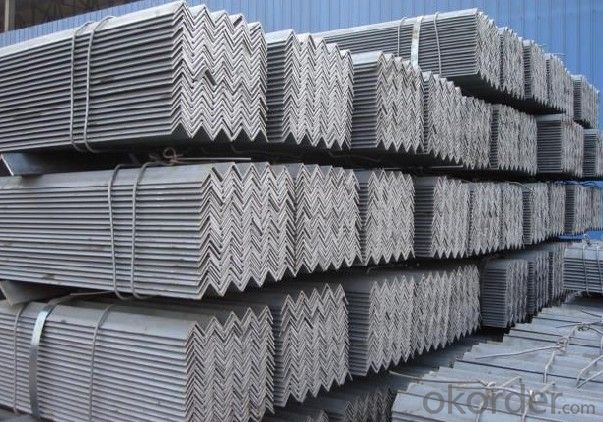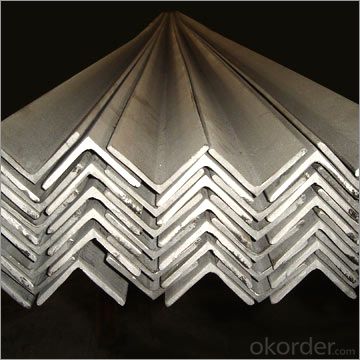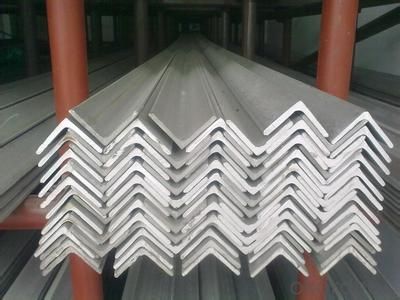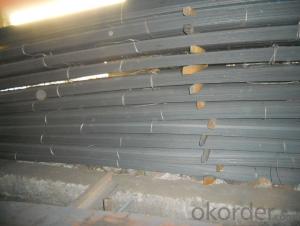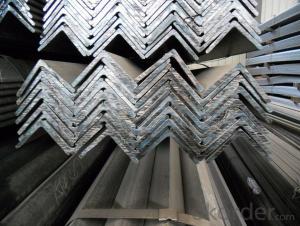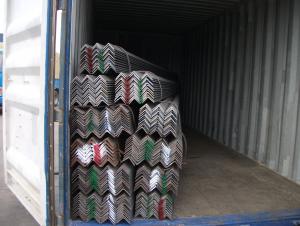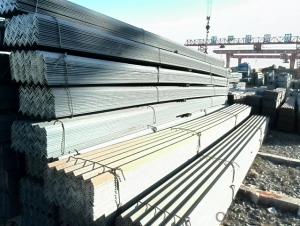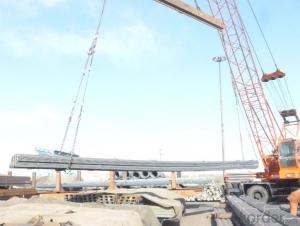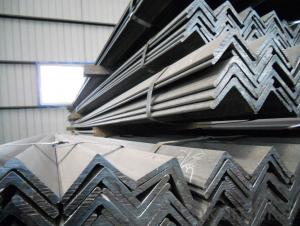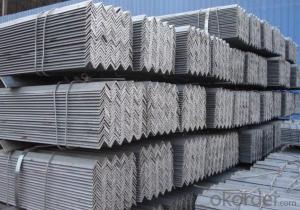Equal Angle Steel Hot Rolled High Qulaity
- Loading Port:
- Tianjin
- Payment Terms:
- TT OR LC
- Min Order Qty:
- 25 m.t.
- Supply Capability:
- 20000000 m.t./month
OKorder Service Pledge
OKorder Financial Service
You Might Also Like
Specification
Product Description:
OKorder is offering Equal Angle Steel Hot Rolled High Qulaity at great prices with worldwide shipping. Our supplier is a world-class manufacturer of steel, with our products utilized the world over. OKorder annually supplies products to European, North American and Asian markets. We provide quotations within 24 hours of receiving an inquiry and guarantee competitive prices.
Product Applications:
According to the needs of different structures, Angle can compose to different force support component, and also can be the connections between components. It is widely used in various building structures and engineering structures such as roof beams, bridges, transmission towers, hoisting machinery and transport machinery, ships, industrial furnaces, reaction tower, container frame and warehouse etc
Product Advantages:
OKorder's Steel Equal Angle Steel Hot Rolled High Qulaity are durable, strong, and resist corrosion.
Main Product Features:
· Premium quality
· Prompt delivery & seaworthy packing (30 days after receiving deposit)
· Corrosion resistance
· Can be recycled and reused
· Mill test certification
· Professional Service
· Competitive pricing
Product Specifications:
Manufacture: Hot rolled
Grade: Q195 – 235
Certificates: ISO, SGS, BV, CIQ
Length: 6m – 12m, as per customer request
Packaging: Export packing, nude packing, bundled
Sizes: 25mm-250mm | ||||||||||||
a*t | ||||||||||||
25*2.5-4.0 | 70*6.0-9.0 | 130*9.0-15 | ||||||||||
30*2.5-6.6 | 75*6.0-9.0 | 140*10-14 | ||||||||||
36*3.0-5.0 | 80*5.0-10 | 150*10-20 | ||||||||||
38*2.3-6.0 | 90*7.0-10 | 160*10-16 | ||||||||||
40*3.0-5.0 | 100*6.0-12 | 175*12-15 | ||||||||||
45*4.0-6.0 | 110*8.0-10 | 180*12-18 | ||||||||||
50*4.0-6.0 | 120*6.0-15 | 200*14-25 | ||||||||||
60*4.0-8.0 | 125*8.0-14 | 250*25 | ||||||||||
FAQ:
Q1: Why buy Materials & Equipment from OKorder.com?
A1: All products offered byOKorder.com are carefully selected from China's most reliable manufacturing enterprises. Through its ISO certifications, OKorder.com adheres to the highest standards and a commitment to supply chain safety and customer satisfaction.
Q2: How do we guarantee the quality of our products?
A2: We have established an advanced quality management system which conducts strict quality tests at every step, from raw materials to the final product. At the same time, we provide extensive follow-up service assurances as required.
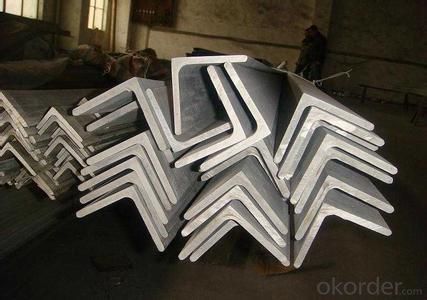
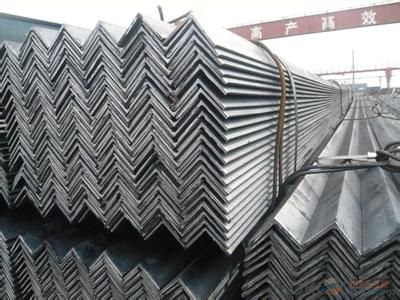
- Q: What are the common uses of unequal steel angles?
- Unequal steel angles are commonly used in construction, engineering, and fabrication projects. They are often used as structural supports, providing stability and strength in frameworks, buildings, and bridges. These angles are also used for creating bracing systems, reinforcing corner joints, and as components in machinery and equipment. Additionally, they are utilized in architectural designs for decorative purposes, adding aesthetic appeal to structures.
- Q: What are the different uses for stainless steel angles?
- Stainless steel angles have a wide range of uses across various industries and applications. Here are some of the different uses for stainless steel angles: 1. Structural Support: Stainless steel angles are commonly used in construction and engineering projects as structural support elements. They provide stability, strength, and durability, making them ideal for framing structures, supporting beams, and reinforcing various load-bearing structures. 2. Architectural Applications: Stainless steel angles are frequently employed in architectural designs. They can be used to create decorative trims, frames, and accents, adding an aesthetic appeal to buildings, bridges, and other structures. 3. Industrial Equipment: Stainless steel angles are used in the manufacturing and assembly of industrial equipment. They can be found in machinery, conveyor systems, and robotics, providing stability and reinforcement in heavy-duty applications. 4. Furniture and Shelving: Stainless steel angles are often used in the construction of furniture and shelving units. They offer stability and support for tables, chairs, storage racks, and display shelves, ensuring long-lasting durability. 5. Automotive Industry: Stainless steel angles are utilized in the automotive industry for various purposes. They are commonly used in the production of frames, chassis, brackets, and suspension components, providing strength and resistance to corrosion. 6. Marine Applications: Stainless steel angles are highly resistant to corrosion, making them ideal for marine applications. They are commonly used in boat building, ship fittings, and offshore structures, where they endure harsh saltwater environments. 7. Food Processing and Medical Industries: Stainless steel angles are widely used in the food processing and medical industries. They are corrosion-resistant, easy to clean, and comply with strict hygiene standards. Stainless steel angles are often used in the construction of food processing equipment, surgical instruments, and medical devices. 8. Decorative and Artistic Applications: Stainless steel angles can be used in artistic and decorative projects. They are often used by sculptors, designers, and metalworkers to create unique and visually appealing structures, sculptures, and installations. In summary, stainless steel angles have multiple uses across various industries, including construction, architecture, industrial manufacturing, automotive, marine, furniture, food processing, medical, and artistic applications. Their strength, durability, and corrosion resistance make them a versatile and reliable choice in many different settings.
- Q: Are steel angles suitable for rooftop installations?
- Yes, steel angles are suitable for rooftop installations. They are commonly used in construction for their strength and durability. Steel angles provide structural support and can be easily attached to rooftops to secure various installations such as solar panels, antennas, or HVAC equipment.
- Q: Can steel angles be used for green building projects?
- Absolutely! Green building projects can definitely utilize steel angles. Steel is an incredibly sustainable and eco-friendly material that boasts durability, recyclability, and energy efficiency. When it comes to construction, steel angles, also referred to as L-shaped steel, are widely recognized for their strength and versatility. They can be employed in a multitude of ways in green building projects, including framing, providing structural support, and reinforcement. One of the major advantages of steel angles is that they are often manufactured using recycled steel. This practice reduces the need for extracting new raw materials and effectively minimizes waste. Moreover, steel can be recycled indefinitely without compromising its strength or quality, making it an incredibly sustainable choice. By incorporating recycled steel angles into green building projects, carbon emissions can be reduced and natural resources can be conserved. Additionally, steel is an energy-efficient material that contributes to the overall energy efficiency of a building. Steel angles can be utilized in the construction of energy-efficient systems, such as structures for mounting solar panels, wind turbine towers, and other renewable energy infrastructure. The strength and durability of steel also enable the design of lightweight structures, which significantly reduces the amount of energy required for construction and transportation. Furthermore, steel angles exhibit resistance to pests, fire, and moisture, ensuring the longevity and durability of green buildings. Their versatility enables seamless integration with other sustainable building materials, such as recycled concrete, wood, and glass, further enhancing the environmental performance of the project. To summarize, the utilization of steel angles in green building projects is unquestionably feasible. Their sustainability, durability, recyclability, and energy efficiency make them an ideal choice for constructing environmentally friendly and sustainable buildings.
- Q: What is the maximum allowable lateral torsional buckling stress for a steel angle?
- The maximum stress that a steel angle can withstand before lateral torsional buckling occurs depends on several factors, including the angle's size, shape, material properties, and the design code being followed. To determine the maximum allowable stress for a steel angle, one can consider the critical moment of inertia and its corresponding critical stress. The critical moment of inertia measures the angle's ability to resist lateral torsional buckling and is affected by its geometry and dimensions. Design codes such as the AISC Manual of Steel Construction or the Eurocode provide specific values for the maximum allowable lateral torsional buckling stress. These codes offer guidelines and formulas for calculating this stress based on the angle's dimensions, material properties, and other factors like effective length and end conditions. To accurately determine the maximum allowable lateral torsional buckling stress for a particular steel angle, it is crucial to refer to the appropriate design code or standard and seek advice from a structural engineer or consult relevant reference materials.
- Q: How are steel angles tested for quality and strength?
- Steel angles are tested for quality and strength through various methods, including visual inspection, measurement of dimensions, and mechanical testing. Visual inspection involves checking for any visible defects or imperfections such as cracks, surface irregularities, or rust. Measurement of dimensions ensures that the angles meet the specified size and shape requirements. Mechanical testing involves subjecting the angles to forces or loads to determine their strength, such as tensile testing to measure their resistance to pulling or bending, and hardness testing to assess their resistance to indentation. These tests help ensure that steel angles meet the desired quality and strength standards.
- Q: What is the process of galvanizing steel angles?
- The process of galvanizing steel angles involves several steps to ensure the steel angles are coated with a layer of zinc for protection against corrosion. Firstly, the steel angles are cleaned to remove any dirt, oil, or rust from the surface. This is typically done through a process called pickling, where the angles are immersed in a solution of acid, usually hydrochloric acid, to remove any impurities. Once the steel angles are cleaned, they are then rinsed to remove any residual acid and dried thoroughly. This is important to ensure proper adhesion of the zinc coating. After the cleaning process, the steel angles are dipped into a bath containing molten zinc. This is done through a process called hot-dip galvanizing, where the angles are fully immersed in the zinc bath. The temperature of the zinc bath is typically around 840°F (449°C). As the steel angles are immersed in the zinc bath, a metallurgical reaction occurs between the steel and the molten zinc. This reaction forms a layer of zinc-iron alloy on the surface of the angles. This layer provides excellent corrosion resistance and acts as a barrier between the steel and the corrosive elements in the environment. After the angles have been fully immersed in the zinc bath, they are then removed and allowed to cool. The cooling process solidifies the zinc coating and ensures its adhesion to the steel angles. Finally, the galvanized steel angles are inspected for quality control. This includes checking the coating thickness, uniformity, and adherence to the angles. Various tests and measurements are performed to ensure that the galvanized coating meets the required standards and specifications. Overall, the process of galvanizing steel angles involves cleaning, immersion in a molten zinc bath, cooling, and inspection. This process provides a durable and long-lasting protective coating on the steel angles, making them resistant to corrosion and extending their lifespan.
- Q: Can steel angles be used in telecommunications tower constructions?
- Yes, steel angles can be used in telecommunications tower constructions. Steel angles are commonly used as structural components in various construction applications, including telecommunications towers. They provide strength, stability, and support to the tower structure. Steel angles can be welded or bolted together to form the framework of the tower, providing a sturdy and durable structure capable of withstanding the weight of the tower and its equipment. Additionally, steel angles can be easily fabricated and customized to meet the specific design and engineering requirements of the telecommunications tower.
- Q: What is the maximum temperature that steel angles can withstand?
- The maximum temperature that steel angles can withstand depends on the grade of steel used. Generally, low carbon steel angles can withstand temperatures up to 600-700 degrees Celsius (1112-1292 degrees Fahrenheit) before their mechanical properties begin to deteriorate. However, higher carbon steels, stainless steels, or alloy steels can withstand higher temperatures, ranging from 800-1200 degrees Celsius (1472-2192 degrees Fahrenheit) or even higher. It is important to consult the specific material specifications or consult with a materials engineer to determine the maximum temperature a particular steel angle can withstand in a specific application.
- Q: Are steel angles resistant to earthquakes?
- Steel angles can provide some level of resistance to earthquakes. Steel is known for its high strength and ductility, making it a suitable material for seismic-resistant construction. Steel angles, also known as steel L-shaped beams, are often used in structural applications to provide support and reinforcement. During an earthquake, steel angles can help distribute the seismic forces evenly throughout the structure, thereby reducing concentrated stress points. The L-shape design of steel angles enables them to resist bending and twisting forces, which are common during seismic events. Additionally, steel angles can be interconnected and welded together to form a rigid frame system, enhancing their seismic resistance. This system can absorb and dissipate energy from earthquake-induced vibrations, minimizing damage to the structure. However, it is important to note that the overall seismic resistance of a structure depends on various factors, such as the design, construction methods, and adherence to building codes and regulations. Steel angles alone cannot guarantee complete protection against earthquakes, but when properly integrated into a well-designed seismic-resistant system, they can significantly enhance the structure's ability to withstand seismic forces.
Send your message to us
Equal Angle Steel Hot Rolled High Qulaity
- Loading Port:
- Tianjin
- Payment Terms:
- TT OR LC
- Min Order Qty:
- 25 m.t.
- Supply Capability:
- 20000000 m.t./month
OKorder Service Pledge
OKorder Financial Service
Similar products
Hot products
Hot Searches
Related keywords

